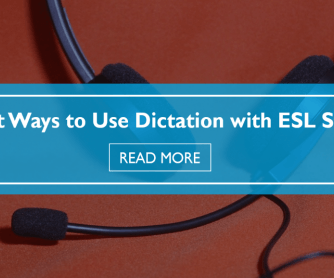
Dictation might feel a bit old-fashioned but it’s a great, interactive way to get students writing and talking. It doesn’t take a lot of preparation time or complex feedback and it can also serve as a springboard to other activities. Consider these ways to incorporate dictation in your ESL classroom.
1. Dictate a Story
There are lots of great, short stories you can dictate all over the internet. For example, the British Council has hundreds of short stories and videos for children and for adults. You can use different variations while dictating the stories. For example, you could jumble the stor and have students rearrange it after they have completed the dictation. You could also have students try to guess the last line of the story or leave out some words for students to fill in later.
2. Dictate Questions
If you have a comprehension activity with a set of questions, perhaps in a course book or worksheet, why not turn the questions into a dictation activity? This way, you can pre-teach the vocab and meaning before students read the text to find out the answers.
3. Dictate Discussion Sentences
Dictating discussion questions at the start of a class is a great way to get students talking, introduce the theme of your class, and get in a bit of writing practise too. For example, if you were beginning a session on travel and tourism, you could dictate the following questions and then get students to discuss them.
- ‘Where did you last go on holiday?’
- ‘Where would you most like to visit in the world?’
- ‘Is there anywhere you wouldn’t like to visit?’
By keeping the dictation short and sweet, you’ll get students used to the activity and will be able to try longer dictation activities in the future.
4. YouTube Speeches or Songs
Find a good speech, song, or poem from the internet and dictate it to students. You could either play the video and then do the dictation or the other way around. Have students try reading and practicing the speech when they have finished writing and listening to it.
5. Rip and Run
This is a great activity for younger learners. Print off target short texts or sentences and stick them on the wall. Put students into groups and have them ‘walk’ or ‘run’ to the texts. Students have to try to remember chunks of the dictation and then run back to their group where they tell the sentence to a partner who writes it down. Then they swap roles. The winning group is the one that finishes first. This can create a rowdy situation, so choose texts that aren't too long.
6. Students Read the Dictation
Cut up the text and give out sentences for some of your students to dictate to the rest of the class. Encourage students to read slowly and clearly so the others can hear. This gets students to appreciate how important pronunciation is and understand that giving a dictation isn’t as simple as they might think.
7. Finish the Sentence
Dictate sentences that students can finish with their own ideas. This is great for practicing a grammar structure that you have just taught. For example, if you are studying the present perfect you could dictate:
- ‘I’ve never been impressed by…’
- ‘Nobody in my family has ever…’
8. Fill in the Gap
Explain to students that as you dictate you are going to replace a word with the sound ‘beep’. Students must complete the dictation as normal but choose the word that fits in the gap. Here are some example sentences to practice past simple irregulars:
- ‘Yesterday I [beep] a wallet in the street’ [found / lost/ saw]
- ‘It was my birthday yesterday and my mum [beep] me a new guitar’ [bought / gave]
Running a Dictation Activity
If you plan to use dictation in your classroom, you should keep the following tips in mind.
- Explain the idea that as you speak, students write the words down.
- Don’t speak too quickly if you have low level learners.
- Don’t speak too simply if you have higher level students.
- As you read, put the sentences into manageable chunks of language.
- Pause and be prepared to wait or repeat what you said.
- Be patient.
Additionally, with each dictation activity, encourage students take charge of making their own corrections. Often this is much more valuable than having you do it for them. There are a number of ways you can provide feedback the corrections. You could simply write the answers on the board or get students to get up and write the answers themselves. Using PowerPoint to display the corrections also works well. You can animate the text so that elements of it ‘fly in’ one by one as you elicit the answers from the students. Another way of adding fun to checking work is to ask students to check their classmate’s writing. They can award one point for every mistake they find and the learner with the lowest score is the winner.
P.S. If you enjoyed this article, please help spread it by clicking one of those sharing buttons below. And if you are interested in more, you should follow our Facebook page where we share more about creative, non-boring ways to teach English.








